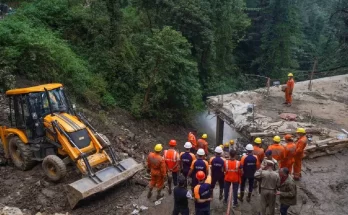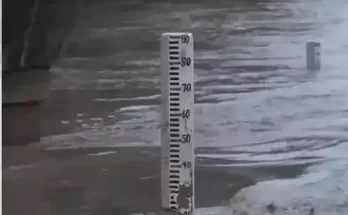Data for report was based on 1961 to 2020 even as experts say frequency of cyclones has risen in the Arabian Sea.

Satellite image taken between 08:00 pm to 08:26 pm IST shows the location of Cyclone Biparjoy in the Arabian Sea on June 14. (Credit: PTI Photo)
New Delhi: When the India Meteorological Department (IMD) launched the first ever ‘Climate Hazards and Vulnerability Atlas of India’ in January 2022, the list of ‘High to very high vulnerable state/UTs for cyclones comprised 10 districts in Tamil Nadu, nine in Andhra Pradesh, six in Odisha, three each of Puducherry and West Bengal and one from the Andaman & Nicobar Islands, all on the east coast of the country.
Gujarat on the west coast, which has borne the brunt of Severe Cyclonic Storm Biparjoy since June 15 evening and continued to be battered on June 16 too, is nowhere on the list. After Tauktae in 2021, this is the second deadly storm emanating from the Arabian Sea.
Explaining why Gujarat is missing from the IMD list, K S Hosalikar from IMD’s Office of Climate Research & Services that had brought out the Atlas said: “There have been changes in the Arabian Sea in the last decade or so. Our listing and analysis is based on data from 1961 to 2020. The events of cyclones on the western coast of India compared to the eastern coast are still less on a long period average (LPA) basis.”
“Another factor is whether or not the cyclone on the western coast makes a landfall in any of the Indian states. Sometimes the cyclones travel towards Pakistan or Oman, sometimes the cyclones fizzle out,” he added.
Changing Arabian Sea?
The warming of the oceans and the changing climate has overall increased the vulnerability on the west coast. In fact, a July 2021 study, ‘Changing Status of Tropical Cyclones in north Indian Ocean’ has mentioned that the frequency, duration, and the intensity of cyclones in the Arabian Sea have increased significantly.
“The intensity of cyclones also has increased in the Arabian Sea, by about 20% (post-monsoon) to 40% (pre-monsoon). There has been a 52% increase in the number of cyclones in the Arabian Sea, while very severe cyclones have increased by 150%,” the study published in Springer Link said, and added, “There has been an 80% increase in the total duration of cyclones in the Arabian Sea during the last two decades. The duration of very severe cyclone has increased by 260%.”
As per the IMD, the frequency of cyclones is more in the Bay of Bengal than in the Arabian Sea, the ratio being 4:1. The IMD data also states that between 1961 and 2021, since the satellite images are available, three extremely severe cyclonic storms crossed Gujarat coast. The first cyclonic storm over the north Indian Ocean during the year 2021, Tauktae was the most intense cyclone after the Kandla cyclone of 1998.
Stating that the Atlas would be updated from time to time, Hosalikar added, “There is no denying that we need to provide strong mitigation methodology, not just early warning system but post-disaster management too.”
On Friday, June 16, after crossing the coast, the Severe Cyclonic Storm ‘Biparjoy’ had weakened into ‘Cyclonic Storm’ and was very likely to move nearly east-northeastwards and weaken further into a Deep Depression over Saurashtra & Kutch and travel towards Rajasthan.
Atul Karwal, National Disaster Rescue Force (NDRF) Director General, told agencies on Friday, “Two people died before landfall. There were no casualties after landfall. Another 23 people have sustained injuries. As many as 24 animals have died too. Power supply was interrupted in about a 1,000 villages. At least 800 trees have fallen.”
Earlier in 2021, Tauktae too had unleashed a lot of damage. Almost a month after Tauktae, Gujarat government paid Rs 12.6 crore to fishermen in Saurashtra area where almost 2,000 boats were damaged partially or fully. As many as 3.5 million trees were uprooted in Gir National Park and surrounding forest areas. Fortunately, the loss of life was restricted to less than 100 but more than 6,500 cattle had died.
(This story first appeared on news9live.com on Jun 16, 2023 and can be read here.)



